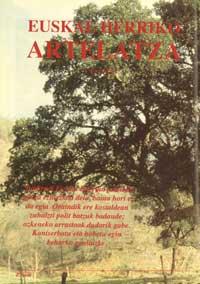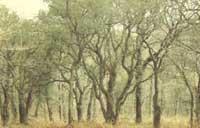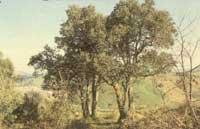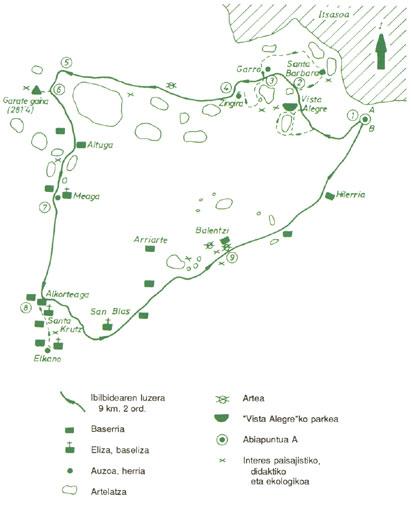Alcornoque de Euskal Herria

The coastal zones mentioned above, sometimes by influence of the coastal climate, have special microclimates. Therefore, it can be understood that the typical plants of the Mediterranean area can appear in these areas.
In Euskal Herria the cork oak appears in some areas on the southern slopes, colonizing the xerophilic places.
On the other hand, in Europe it extends to the Mediterranean coast and to the south and west of the Iberian Peninsula. In the North it is from time to time and in France it reaches the Southwest (Landa). It extends in North Africa, specifically to Morocco, Algeria and Tunisia. Most of the cork oak is located in Portugal and the largest forest in Morocco. In the case of Euskal Herria, in addition to some populations of Iparralde (Baiona and Biarritz), the area of Zarautz and Getaria is its most important population centre. Moreover, in the area of Bizkaia there is only some grove and some single species planted.

In the face of geology and soil, the cork oak is placed mainly on the silicon material, characteristic of this tree.
In the surroundings of Zarautz and Getaria are very abundant the eocene-paleocene materials (especially sandstone) and on them is the cork oak. However, despite its silicon hobby, in some areas it also appears on painted soil.
Cork oak is very similar to art, but they are easily distinguished on the surface, since the bark is spongy and cracked (cork). It can be a tree about twenty meters or more. Its leaves are green and bright, relatively small. The leaves are durable and somewhat hairy at the bottom. They are similar to the art sheets. Small male flowers, lentils, located at the ends of the branches or twigs. The females, on the other hand, are of short peduncle and grouped in very small groups.

The fruit of the cork oak is the acorn, brown and egg-shaped (elongated). The bark is cork and light brown. In some places it is very used, since with it cork blocks are made. It does not seem that it has been used in Euskal Herria to obtain cork. The wood is reddish brown, very hard. This wood is used in the wood industry, bodywork and shipbuilding. Also for coal and fire.
Historical evolution of cork oak

The analysis of the historical evolution of cork oak is quite difficult due to the lack of materials. However, the baserritarras of the area and the books on the history of Zarautz indicate something.
In the words of old travelers, the surroundings of Zarautz have been, like many others, a botanical paradise in which its presence stands out. There is XVII. Several written references to the work of art of the twentieth century: 56 cork oak trees in the area of Santa Bárbara de Zarautz, 350 specimens next to the hamlet Kajuategi, etc. In addition, these forests were cared for, although it was not yet known what their use was.

It can also be very interesting to make a small mention of the name of this tree. In Zarautz and Getaria it is known as arkamurka or arkamuka. It seems that the word arkamurka can come from the word alcornoque in Spanish, considering that the word “cork oak” is used in the toponymy of Zarautz:
Alkornokal was a land, he was in Zarautz and his translation into Spanish would be the place of cork oak trees. We have known that this word is of Arab origin.

The word Alkornokaldea was the name of an Argomal. It comes from Alcornoque and the established suffix means environment (-alde). This mention is interesting. The year in which it was to be used is unknown, but before being an argoma it would have become a cork oak. As is known, otea is produced in degraded forests.
Alkornokegi is the name of an apple tree. An interesting starting point to theorize without a doubt. The presence of a cork oak before Sagasti does not seem difficult.

On the other hand, the term "alkornoke" is often heard among the baserritarras. It is nothing more than a translation. The official name of alcornoque is not used by baserritarras.
No information has been found on the use, but it has been proven that cork oak forests were taken care of and used for something. The cork has not been cultivated, but for reasons of the shipbuilding could have used its wood. The demand for wood for fire was also high. It does not seem that, despite its good fruit, it was used for livestock.
Conservation of cork oak

The cork oak tree is in serious danger and to preserve the last remaining trees and specimens, we should take concrete measures
...Some of these measures could be:
- Ban cork oak (some baserritarras use it for fire) and cut cork, which is frequently used to make Christmas births.
- Develop the fecundation of acorns among solids, since the possibility of fertilization is very large.
 Cork trunk, with good separation of cork.
Cork trunk, with good separation of cork. - Avoid harmful actions in the stem of pines, since in these pine trees there is a lot of cork oak trees.
- It would be obligatory to protect the best sketches and sketches.
- Generate a positive awareness in schools and the population in general through the ecological didactic information.
- Perform a thorough follow-up, keeping the population in good condition.
Ecological route between cork oak trees:
With this tour we can see most of the cork oak trees that appear in Euskal Herria. The landscape is unbeatable and still some ancient sketches are preserved as relics.
- We take the road to the Meaga that leaves next to the Parish of Zarautz and after passing the Residence of Elders we go up the road to the park of “Vista Alegre”. In it you can see cork bushes, but also many other species appear.
- After passing the park of “Vista Alegre”, Sta. We will arrive at the crossing of Bárbara. Go up to the hermitage. From here you can see the cork oak trees and the landscape.
- Pass through the hamlet Garro. If you take the point road, you can see the cork oak that chokes the pine. After passing through the hamlet Zingira, take the road that goes up.
- See well the cork sketches visible from the road.
- Eye, crossing. We pass the road and go up the high of Gárate, then turn right.
- Returning along the same road by the high of Garate and taking the road that comes from Maia, we descend to the right until the hermitage of Meagas. Meanwhile, enjoy beautiful cork oak trees.
- Eye! Crossing of Meaga. Crossing the road that comes from Zarautz, we take the road that leads to Elcano.
- Before arriving to the hamlet Alkorteaga, we leave the road and turn right. If you take the point road we will arrive to the neighborhood of Elcano.
- From the descent road we will arrive to the hamlet Balentzi. See the existing art and compare it with the cork oak. Following the road we will arrive to the neighborhood zarauztarra of Zalbide.






